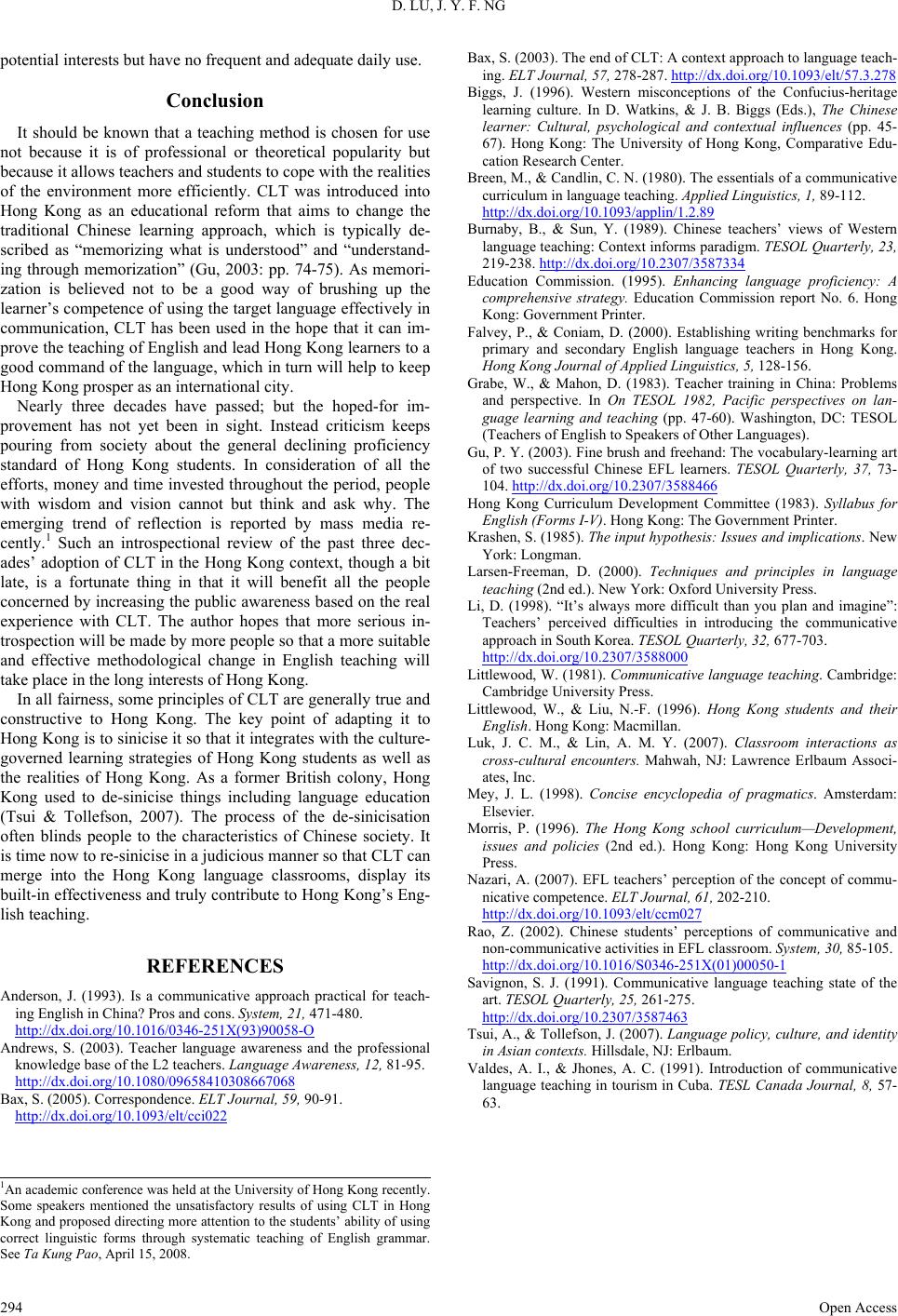
D. LU, J. Y. F. NG
Open Access
294
potential interests but have no frequent and adequate daily use.
Conclusion
It should be known that a teaching method is chosen for use
not because it is of professional or theoretical popularity but
because it allows teachers and students to cope with the realities
of the environment more efficiently. CLT was introduced into
Hong Kong as an educational reform that aims to change the
traditional Chinese learning approach, which is typically de-
scribed as “memorizing what is understood” and “understand-
ing through memorization” (Gu, 2003: pp. 74-75). As memori-
zation is believed not to be a good way of brushing up the
learner’s competence of using the target language effectively in
communication, CLT has been used in the hope that it can im-
prove the teaching of English and lead Hong Kong learners to a
good command of the language, which in turn will help to keep
Hong Kong prosper as an international city.
Nearly three decades have passed; but the hoped-for im-
provement has not yet been in sight. Instead criticism keeps
pouring from society about the general declining proficiency
standard of Hong Kong students. In consideration of all the
efforts, money and time invested throughout the period, people
with wisdom and vision cannot but think and ask why. The
emerging trend of reflection is reported by mass media re-
cently.1 Such an introspectional review of the past three dec-
ades’ adoption of CLT in the Hong Kong context, though a bit
late, is a fortunate thing in that it will benefit all the people
concerned by increasing the public awareness based on the real
experience with CLT. The author hopes that more serious in-
trospection will be made by more people so that a more suitable
and effective methodological change in English teaching will
take place in the long interests of Hong Kong.
In all fairness, some principles of CLT are gene rally true and
constructive to Hong Kong. The key point of adapting it to
Hong Kong is to sinicise it so that it integrates with the culture-
governed learning strategies of Hong Kong students as well as
the realities of Hong Kong. As a former British colony, Hong
Kong used to de-sinicise things including language education
(Tsui & Tollefson, 2007). The process of the de-sinicisation
often blinds people to the characteristics of Chinese society. It
is time now to re-sinicise in a judicious manner so that CLT can
merge into the Hong Kong language classrooms, display its
built-in effectiveness and truly contribute to Hong Kong’s Eng-
lish teaching.
REFERENCES
Anderson, J. (1993). Is a communicative approach practical for teach-
ing English in China? Pros and cons. System, 21, 471-480.
http://dx.doi.org/10.1016/0346-251X(93)90058-O
Andrews, S. (2003). Teacher language awareness and the professional
knowledge base of the L2 teachers. Language Awareness, 12, 81-95.
http://dx.doi.org/10.1080/09658410308667068
Bax, S. (2005). Correspondence. ELT Journal, 59, 90-91.
http://dx.doi.org/10.1093/elt/cci022
Bax, S. (2003). The end of CLT: A context approach to language teach-
ing. ELT Journal, 57, 278-287. http://dx.doi.org/10.1093/elt/57.3.278
Biggs, J. (1996). Western misconceptions of the Confucius-heritage
learning culture. In D. Watkins, & J. B. Biggs (Eds.), The Chinese
learner: Cultural, psychological and contextual influences (pp. 45-
67). Hong Kong: The University of Hong Kong, Comparative Edu-
cation Research Center.
Breen, M., & Candlin, C. N. (1980). The essentials of a communicative
curriculum in language teachin g. Applied Linguistics, 1, 89-112.
http://dx.doi.org/10.1093/applin/1.2.89
Burnaby, B., & Sun, Y. (1989). Chinese teachers’ views of Western
language teaching: Context informs paradigm. TESOL Quarterly, 23,
219-238. http://dx.doi.org/10.2307/3587334
Education Commission. (1995). Enhancing language proficiency: A
comprehensive strategy. Education Commission report No. 6. Hong
Kong: Government Printer.
Falvey, P., & Coniam, D. (2000). Establishing writing benchmarks for
primary and secondary English language teachers in Hong Kong.
Hong Kong Journal of Applied Linguistics, 5, 128-156.
Grabe, W., & Mahon, D. (1983). Teacher training in China: Problems
and perspective. In On TESOL 1982, Pacific perspectives on lan-
guage learning and teaching (pp. 47-60). Washington, DC: TESOL
(Teachers of English to Speakers of Other Languages).
Gu, P. Y. (2003). Fine brush and freehand: The vocabulary-learning art
of two successful Chinese EFL learners. TESOL Quarterly, 37, 73-
104. http://dx.doi.org/10.2307/3588466
Hong Kong Curriculum Development Committee (1983). Syllabus for
English (Forms I-V). Hong Kong: The Government Printer.
Krashen, S. (1985). The input hypothesis: Issues and implications. New
York: Longman.
Larsen-Freeman, D. (2000). Techniques and principles in language
teaching (2nd ed.). New York: Oxford Univers ity Press.
Li, D. (1998). “It’s always more difficult than you plan and imagine”:
Teachers’ perceived difficulties in introducing the communicative
approach in South Korea. TESOL Quarterly, 32, 677-703.
http://dx.doi.org/10.2307/3588000
Littlewood, W. (1981). Communicative language teaching. Cambridge:
Cambridge University Press.
Littlewood, W., & Liu, N.-F. (1996). Hong Kong students and their
English. Hong Kong: Macmillan.
Luk, J. C. M., & Lin, A. M. Y. (2007). Classroom interactions as
cross-cultural encounters. Mahwah, NJ: Lawrence Erlbaum Associ-
ates, Inc.
Mey, J. L. (1998). Concise encyclopedia of pragmatics. Amsterdam:
Elsevier.
Morris, P. (1996). The Hong Kong school curriculum—Development,
issues and policies (2nd ed.). Hong Kong: Hong Kong University
Press.
Nazari, A. (2007). EFL teachers’ perception of the concept of commu-
nicative competence. ELT Jour na l, 61, 202-210.
http://dx.doi.org/10.1093/elt/ccm027
Rao, Z. (2002). Chinese students’ perceptions of communicative and
non-communicative activities i n EFL classroom. System, 30, 85-105.
http://dx.doi.org/10.1016/S0346-251X(01)00050-1
Savignon, S. J. (1991). Communicative language teaching state of the
art. TESOL Quarterly, 25, 261-275.
http://dx.doi.org/10.2307/3587463
Tsui, A., & Tollefson, J. (2007). Language policy, culture, and identity
in Asian contexts. Hillsdale, NJ: Erlbaum.
Valdes, A. I., & Jhones, A. C. (1991). Introduction of communicative
language teaching in tourism in Cuba. TESL Canada Journal, 8, 57-
63.
1An academic co nf eren ce was h eld at th e Uni ver si ty of Hong Kong recen tly.
Some speakers mentioned the unsatisfactory results of using CLT in Hong
Kong and proposed directing more attention to the students’ ability of using
correct linguistic forms through systematic teaching of English grammar.
See Ta Kung Pao, April 15, 2008.